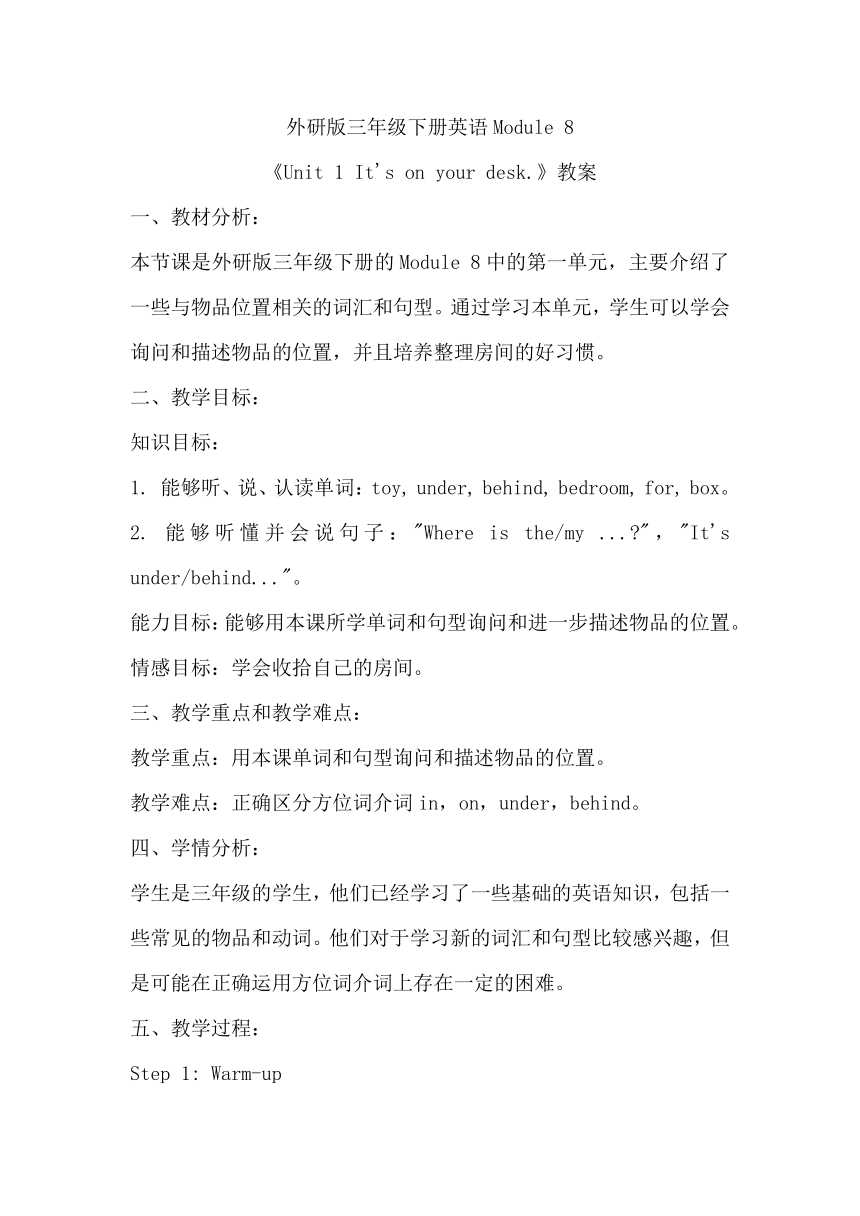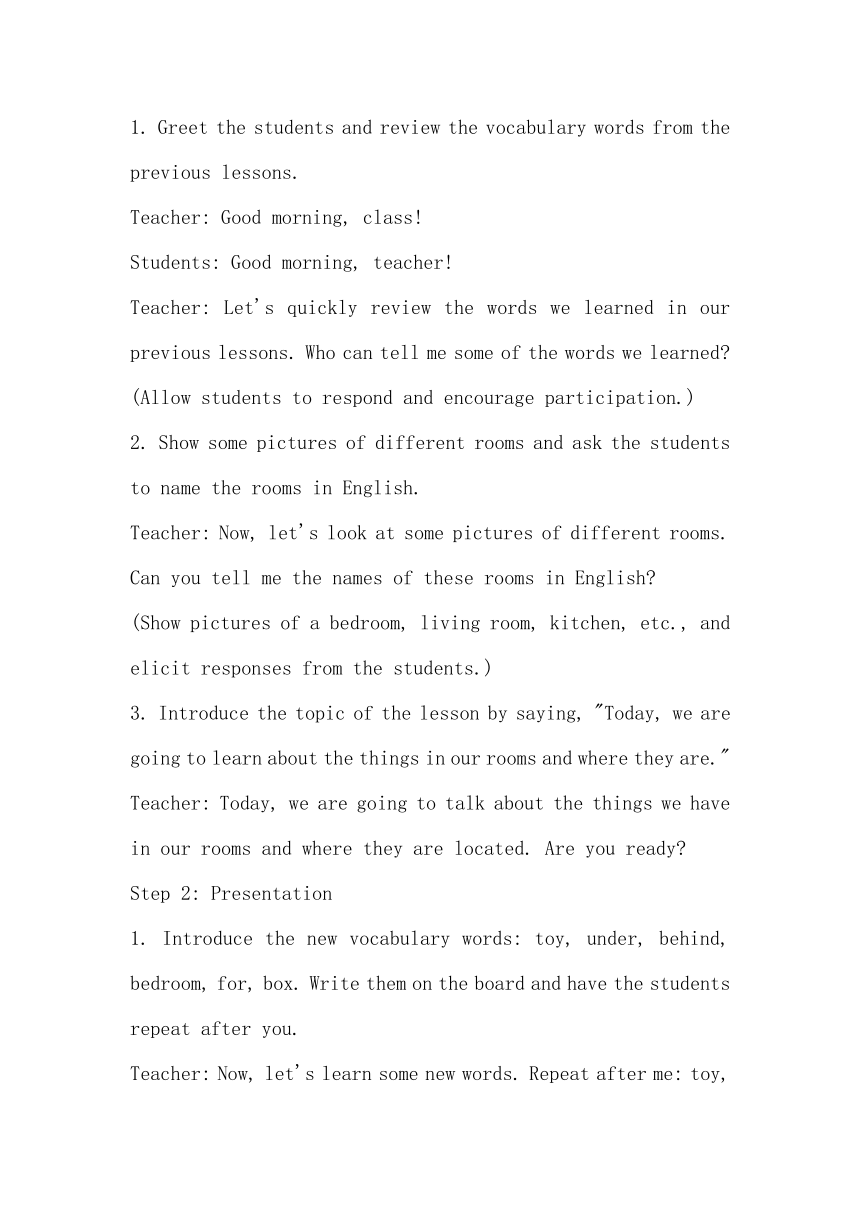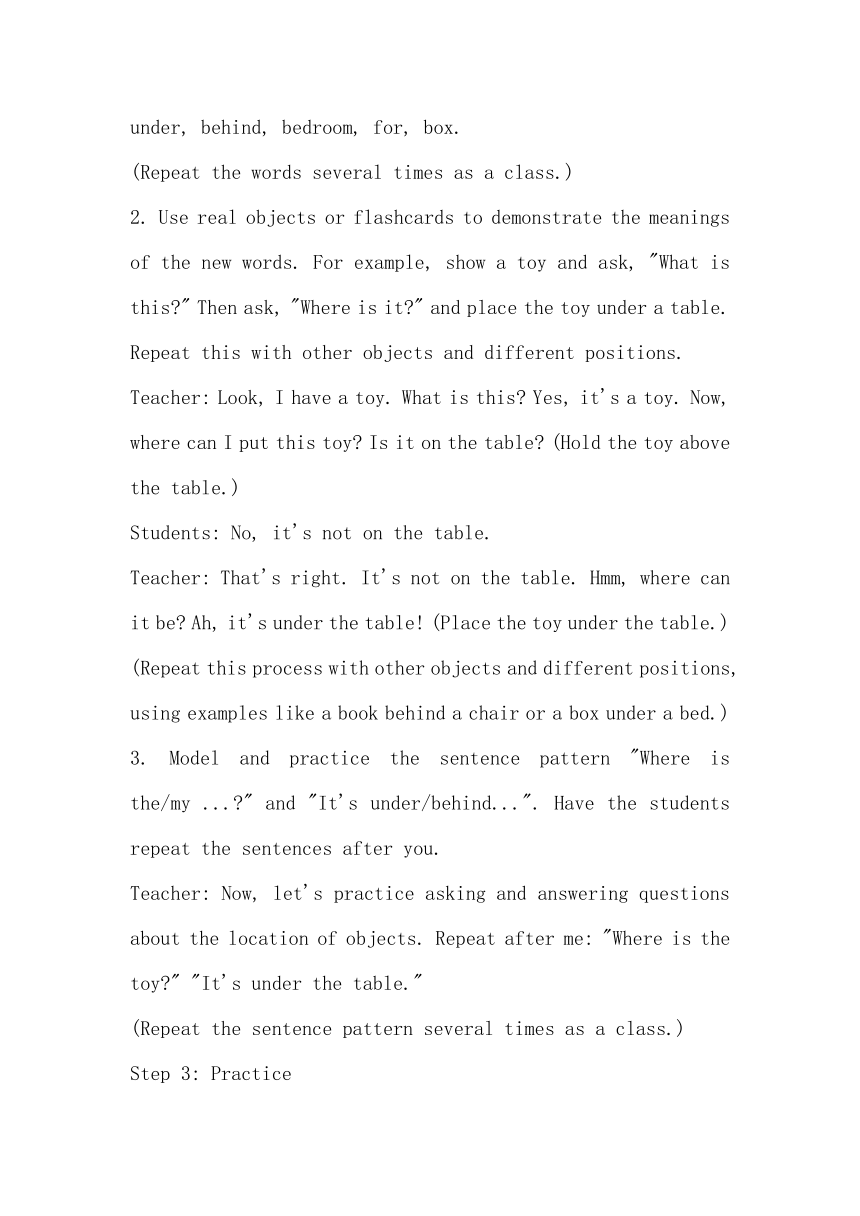Module 8 Unit 1 It's on your desk.教案
文档属性
| 名称 | Module 8 Unit 1 It's on your desk.教案 |

|
|
| 格式 | docx | ||
| 文件大小 | 14.9KB | ||
| 资源类型 | 教案 | ||
| 版本资源 | 外研版(三年级起点) | ||
| 科目 | 英语 | ||
| 更新时间 | 2024-02-05 08:19:19 | ||
图片预览



文档简介
外研版三年级下册英语Module 8
《Unit 1 It's on your desk.》教案
一、教材分析:
本节课是外研版三年级下册的Module 8中的第一单元,主要介绍了一些与物品位置相关的词汇和句型。通过学习本单元,学生可以学会询问和描述物品的位置,并且培养整理房间的好习惯。
二、教学目标:
知识目标:
1. 能够听、说、认读单词:toy, under, behind, bedroom, for, box。
2. 能够听懂并会说句子:"Where is the/my ... ","It's under/behind..."。
能力目标:能够用本课所学单词和句型询问和进一步描述物品的位置。
情感目标:学会收拾自己的房间。
三、教学重点和教学难点:
教学重点:用本课单词和句型询问和描述物品的位置。
教学难点:正确区分方位词介词in,on,under,behind。
四、学情分析:
学生是三年级的学生,他们已经学习了一些基础的英语知识,包括一些常见的物品和动词。他们对于学习新的词汇和句型比较感兴趣,但是可能在正确运用方位词介词上存在一定的困难。
五、教学过程:
Step 1: Warm-up
1. Greet the students and review the vocabulary words from the previous lessons.
Teacher: Good morning, class!
Students: Good morning, teacher!
Teacher: Let's quickly review the words we learned in our previous lessons. Who can tell me some of the words we learned
(Allow students to respond and encourage participation.)
2. Show some pictures of different rooms and ask the students to name the rooms in English.
Teacher: Now, let's look at some pictures of different rooms. Can you tell me the names of these rooms in English
(Show pictures of a bedroom, living room, kitchen, etc., and elicit responses from the students.)
3. Introduce the topic of the lesson by saying, "Today, we are going to learn about the things in our rooms and where they are."
Teacher: Today, we are going to talk about the things we have in our rooms and where they are located. Are you ready
Step 2: Presentation
1. Introduce the new vocabulary words: toy, under, behind, bedroom, for, box. Write them on the board and have the students repeat after you.
Teacher: Now, let's learn some new words. Repeat after me: toy, under, behind, bedroom, for, box.
(Repeat the words several times as a class.)
2. Use real objects or flashcards to demonstrate the meanings of the new words. For example, show a toy and ask, "What is this " Then ask, "Where is it " and place the toy under a table. Repeat this with other objects and different positions.
Teacher: Look, I have a toy. What is this Yes, it's a toy. Now, where can I put this toy Is it on the table (Hold the toy above the table.)
Students: No, it's not on the table.
Teacher: That's right. It's not on the table. Hmm, where can it be Ah, it's under the table! (Place the toy under the table.)
(Repeat this process with other objects and different positions, using examples like a book behind a chair or a box under a bed.)
3. Model and practice the sentence pattern "Where is the/my ... " and "It's under/behind...". Have the students repeat the sentences after you.
Teacher: Now, let's practice asking and answering questions about the location of objects. Repeat after me: "Where is the toy " "It's under the table."
(Repeat the sentence pattern several times as a class.)
Step 3: Practice
1. Divide the class into pairs or small groups.
Teacher: Now, I want you to work in pairs or small groups. Find a partner or join a group.
(Allow students to form pairs or groups.)
2. Give each group a set of picture cards depicting different objects and locations.
Teacher: Here are some picture cards for each group. Each card has a picture of an object and a location. Take turns asking and answering questions using the sentence pattern we practiced.
(Distribute the picture cards to each group.)
3. In turns, one student asks, "Where is the ... " and the other student responds with sentences like "It's under/behind..." based on the picture cards they have.
Teacher: Student A, pick a card and ask Student B, "Where is the toy " Student B, look at the picture and respond using the correct sentence pattern.
(Monitor the students' practice and provide assistance when needed.)
4. Monitor the students' practice and provide assistance when needed.
Teacher: Great job, everyone! I can see you are doing well. Keep practicing and helping each other.
Step 4: Consolidation
1. Play a game of "Simon Says" using the target vocabulary and sentence pattern. For example, say, "Simon says, 'Put the toy under the chair.'" The students should follow the instructions and practice using the correct vocabulary and sentence pattern.
Teacher: Now, let's play a game of "Simon Says." Listen carefully to the instructions and do the actions only if I say "Simon says." For example, if I say, "Simon says, 'Put the toy under the chair,'" you should do it. Let's begin!
(Play a few rounds of "Simon Says" using different instructions and encourage the students to use the target vocabulary and sentence pattern.)
2. Have a class discussion about the importance of keeping their rooms clean and organized. Ask questions like, "Why is it important to keep our rooms tidy " and "How can we keep our rooms organized "
Teacher: Now, let's talk about the importance of keeping our rooms clean and organized. Why do you think it's important How can we keep our rooms tidy
(Facilitate aclass discussion, allowing students to share their thoughts and ideas.)
Step 5: Wrap-up
1. Review the vocabulary words and sentence patterns learned in the lesson.
Teacher: Before we finish, let's quickly review the vocabulary words and sentence patterns we learned today. Repeat after me: toy, under, behind, bedroom, for, box. Now, let's practice the sentence pattern. I will say a word, and you respond with a sentence using the pattern. For example, if I say "toy," you should say, "Where is the toy It's under the table."
(Review the vocabulary and sentence patterns with the class.)
2. Assign a simple homework task, such as drawing a picture of their bedroom and labeling the objects using the new vocabulary words.
Teacher: For homework, I want you to draw a picture of your bedroom. Label the objects in your room using the new words we learned today. Don't forget to write the locations of the objects as well. You can be as creative as you like!
(Explain the homework task to the students and encourage them to be creative.)
Teacher: Well done, everyone! You did a fantastic job today. I'm proud of your progress. See you all in our next lesson!
Note: The above teaching process is a detailed expansion of the original plan. It includes teacher-student interaction, examples, and specific instructions to make the lesson more engaging and effective.
六、板书设计:
Toy - Under - Behind - Bedroom - For - Box
"Where is the/my ... " "It's under/behind..."
七、教学反思:
本节课通过引入新的词汇和句型,让学生能够询问和描述物品的位置。通过图片、实物和游戏等多种形式的教学活动,帮助学生理解并运用这些新的词汇和句型。在教学过程中,教师需要及时给予学生指导和帮助,确保他们能够正确地使用方位词介词。通过这样的教学设计,学生可以在积极参与的氛围中学习和掌握目标知识和能力。通过游戏和讨论,学生还能培养整理房间的好习惯和情感目标。教师在教学过程中需要关注学生的学习情况,及时给予帮助和鼓励,确保每个学生都能够参与到课堂中来。教师还需要在教学结束后进行反思,总结教学的有效性,以便不断改进教学方法和策略。通过这样的教学过程,学生可以在轻松愉快的氛围中学习英语,并且能够在实际生活中运用所学的知识和能力。
《Unit 1 It's on your desk.》教案
一、教材分析:
本节课是外研版三年级下册的Module 8中的第一单元,主要介绍了一些与物品位置相关的词汇和句型。通过学习本单元,学生可以学会询问和描述物品的位置,并且培养整理房间的好习惯。
二、教学目标:
知识目标:
1. 能够听、说、认读单词:toy, under, behind, bedroom, for, box。
2. 能够听懂并会说句子:"Where is the/my ... ","It's under/behind..."。
能力目标:能够用本课所学单词和句型询问和进一步描述物品的位置。
情感目标:学会收拾自己的房间。
三、教学重点和教学难点:
教学重点:用本课单词和句型询问和描述物品的位置。
教学难点:正确区分方位词介词in,on,under,behind。
四、学情分析:
学生是三年级的学生,他们已经学习了一些基础的英语知识,包括一些常见的物品和动词。他们对于学习新的词汇和句型比较感兴趣,但是可能在正确运用方位词介词上存在一定的困难。
五、教学过程:
Step 1: Warm-up
1. Greet the students and review the vocabulary words from the previous lessons.
Teacher: Good morning, class!
Students: Good morning, teacher!
Teacher: Let's quickly review the words we learned in our previous lessons. Who can tell me some of the words we learned
(Allow students to respond and encourage participation.)
2. Show some pictures of different rooms and ask the students to name the rooms in English.
Teacher: Now, let's look at some pictures of different rooms. Can you tell me the names of these rooms in English
(Show pictures of a bedroom, living room, kitchen, etc., and elicit responses from the students.)
3. Introduce the topic of the lesson by saying, "Today, we are going to learn about the things in our rooms and where they are."
Teacher: Today, we are going to talk about the things we have in our rooms and where they are located. Are you ready
Step 2: Presentation
1. Introduce the new vocabulary words: toy, under, behind, bedroom, for, box. Write them on the board and have the students repeat after you.
Teacher: Now, let's learn some new words. Repeat after me: toy, under, behind, bedroom, for, box.
(Repeat the words several times as a class.)
2. Use real objects or flashcards to demonstrate the meanings of the new words. For example, show a toy and ask, "What is this " Then ask, "Where is it " and place the toy under a table. Repeat this with other objects and different positions.
Teacher: Look, I have a toy. What is this Yes, it's a toy. Now, where can I put this toy Is it on the table (Hold the toy above the table.)
Students: No, it's not on the table.
Teacher: That's right. It's not on the table. Hmm, where can it be Ah, it's under the table! (Place the toy under the table.)
(Repeat this process with other objects and different positions, using examples like a book behind a chair or a box under a bed.)
3. Model and practice the sentence pattern "Where is the/my ... " and "It's under/behind...". Have the students repeat the sentences after you.
Teacher: Now, let's practice asking and answering questions about the location of objects. Repeat after me: "Where is the toy " "It's under the table."
(Repeat the sentence pattern several times as a class.)
Step 3: Practice
1. Divide the class into pairs or small groups.
Teacher: Now, I want you to work in pairs or small groups. Find a partner or join a group.
(Allow students to form pairs or groups.)
2. Give each group a set of picture cards depicting different objects and locations.
Teacher: Here are some picture cards for each group. Each card has a picture of an object and a location. Take turns asking and answering questions using the sentence pattern we practiced.
(Distribute the picture cards to each group.)
3. In turns, one student asks, "Where is the ... " and the other student responds with sentences like "It's under/behind..." based on the picture cards they have.
Teacher: Student A, pick a card and ask Student B, "Where is the toy " Student B, look at the picture and respond using the correct sentence pattern.
(Monitor the students' practice and provide assistance when needed.)
4. Monitor the students' practice and provide assistance when needed.
Teacher: Great job, everyone! I can see you are doing well. Keep practicing and helping each other.
Step 4: Consolidation
1. Play a game of "Simon Says" using the target vocabulary and sentence pattern. For example, say, "Simon says, 'Put the toy under the chair.'" The students should follow the instructions and practice using the correct vocabulary and sentence pattern.
Teacher: Now, let's play a game of "Simon Says." Listen carefully to the instructions and do the actions only if I say "Simon says." For example, if I say, "Simon says, 'Put the toy under the chair,'" you should do it. Let's begin!
(Play a few rounds of "Simon Says" using different instructions and encourage the students to use the target vocabulary and sentence pattern.)
2. Have a class discussion about the importance of keeping their rooms clean and organized. Ask questions like, "Why is it important to keep our rooms tidy " and "How can we keep our rooms organized "
Teacher: Now, let's talk about the importance of keeping our rooms clean and organized. Why do you think it's important How can we keep our rooms tidy
(Facilitate aclass discussion, allowing students to share their thoughts and ideas.)
Step 5: Wrap-up
1. Review the vocabulary words and sentence patterns learned in the lesson.
Teacher: Before we finish, let's quickly review the vocabulary words and sentence patterns we learned today. Repeat after me: toy, under, behind, bedroom, for, box. Now, let's practice the sentence pattern. I will say a word, and you respond with a sentence using the pattern. For example, if I say "toy," you should say, "Where is the toy It's under the table."
(Review the vocabulary and sentence patterns with the class.)
2. Assign a simple homework task, such as drawing a picture of their bedroom and labeling the objects using the new vocabulary words.
Teacher: For homework, I want you to draw a picture of your bedroom. Label the objects in your room using the new words we learned today. Don't forget to write the locations of the objects as well. You can be as creative as you like!
(Explain the homework task to the students and encourage them to be creative.)
Teacher: Well done, everyone! You did a fantastic job today. I'm proud of your progress. See you all in our next lesson!
Note: The above teaching process is a detailed expansion of the original plan. It includes teacher-student interaction, examples, and specific instructions to make the lesson more engaging and effective.
六、板书设计:
Toy - Under - Behind - Bedroom - For - Box
"Where is the/my ... " "It's under/behind..."
七、教学反思:
本节课通过引入新的词汇和句型,让学生能够询问和描述物品的位置。通过图片、实物和游戏等多种形式的教学活动,帮助学生理解并运用这些新的词汇和句型。在教学过程中,教师需要及时给予学生指导和帮助,确保他们能够正确地使用方位词介词。通过这样的教学设计,学生可以在积极参与的氛围中学习和掌握目标知识和能力。通过游戏和讨论,学生还能培养整理房间的好习惯和情感目标。教师在教学过程中需要关注学生的学习情况,及时给予帮助和鼓励,确保每个学生都能够参与到课堂中来。教师还需要在教学结束后进行反思,总结教学的有效性,以便不断改进教学方法和策略。通过这样的教学过程,学生可以在轻松愉快的氛围中学习英语,并且能够在实际生活中运用所学的知识和能力。
同课章节目录
- Module 1
- Unit 1 It's the ABC song.
- Unit 2 My favourite colour is yellow.
- Module 2
- Unit 1 They are monkeys.
- Unit 2 The man is short.
- Module 3
- Unit 1 I like football.
- Unit 2 I don't like riding my bike.
- Module 4
- Unit 1 Do you like meat?
- Unit 2 Does Lingling like oranges?
- Module 5
- Unit 1 She goes to school on Mondays.
- Unit 2 Does your mum go to work on Saturdays?
- Module 6
- Unit 1 What do you do on Sundays?
- Unit 2 What does Lingling have at school?
- Module 7
- Unit 1 We fly kites in spring.
- Unit 2 It's warm today.
- Module 8
- Unit 1 It's on your desk.
- Unit 2 Daming flies a kite in the park.
- Module 9
- Unit 1 I've got a new book.
- Unit 2 Has Amy got a bike?
- Review Module
- Unit 1
- Unit 2
- Module 10
- Unit 1 Here's a red hat.
- Unit 2 She's got an orange sweater.
